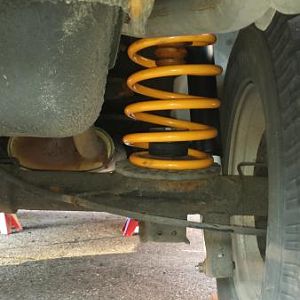Gentleman
Full Access Member
Thi is what the 05 FSM says regarding the system, I don't pretend to understand it but thought it may make insteresting reading for someone smarter than me.
Bob
The tire pressure monitoring system is designed to operate without loss of function for all types of standard tire constructions. (Function with different
types of run flat tire constructions needs to be evaluated for each design). The wheel sensor shall monitor tire pressure, air temperature inside the tire, wheel acceleration and the sensor internal battery status for all four active road tires and the spare tire, if so equipped. The sensor will broadcast this information, along with a unique 32 bit ID, to a central
receiver circuit located inside the WCM. The information received by the WCM will be decoded and stored in (RAM) memory in the WCM. The WCM will send bus messages to the re-configurable display module to display the pressures of the four active road tires in vehicle position. The spare tire pressure is monitored but it is not displayed. If a warning or fault condition exists, the WCM will send a bus message request to display the text messages and, when required, illuminate the amber colored ISO Indicator Lamp. Warnings and faults are described in more detail below. If the WCM detects a warning or fault condition at ignition key on it will wait ten seconds +/- 10% before sending the first request to illuminate the Indicator Lamp and to display the text messages. This will assure that the display module has concluded its bulb check period. The display module will request a chime once per ignition cycle for each warning or fault condition detected. A warning or fault condition will remain enabled until the problem causing the condition is corrected and removed/reset
The WCM shall continuously monitor for the receipt of tire pressure RF message transmissions from the wheel sensors during both the ignition key on and key off cycles. The wheel sensor ID’s and the location of each sensor (e.g. Left Front, Right Front etc.) are stored in the WCM non-volatile memory during the initial Manufacturing Plant Process, or during a service procedure, as required. The recommended placard pressure and the low-pressure threshold for the tires installed on the vehicle, are stored in the WCM non-volatile memory during the initial Manufacturing Plant Process, as described later in this document and in the TPM assembly process standard, or during a service procedure as required. (Note: If more than one placard value is recommended for the vehicle to handle a wide variation in vehicle load requirements, either an automatic (adaptive) means to set the low-pressure threshold or a customer selectable (reset switch) means to set the low-pressure threshold will be provided. For vehicles with optional wheel/tire sizes and significantly different tire placard pressures, the placard pressure value and the low-pressure threshold value shall be re-programmable by the dealer to accommodate the customer selected wheel/tire combinations recommended by DaimlerChrysler).
Bob
The tire pressure monitoring system is designed to operate without loss of function for all types of standard tire constructions. (Function with different
types of run flat tire constructions needs to be evaluated for each design). The wheel sensor shall monitor tire pressure, air temperature inside the tire, wheel acceleration and the sensor internal battery status for all four active road tires and the spare tire, if so equipped. The sensor will broadcast this information, along with a unique 32 bit ID, to a central
receiver circuit located inside the WCM. The information received by the WCM will be decoded and stored in (RAM) memory in the WCM. The WCM will send bus messages to the re-configurable display module to display the pressures of the four active road tires in vehicle position. The spare tire pressure is monitored but it is not displayed. If a warning or fault condition exists, the WCM will send a bus message request to display the text messages and, when required, illuminate the amber colored ISO Indicator Lamp. Warnings and faults are described in more detail below. If the WCM detects a warning or fault condition at ignition key on it will wait ten seconds +/- 10% before sending the first request to illuminate the Indicator Lamp and to display the text messages. This will assure that the display module has concluded its bulb check period. The display module will request a chime once per ignition cycle for each warning or fault condition detected. A warning or fault condition will remain enabled until the problem causing the condition is corrected and removed/reset
The WCM shall continuously monitor for the receipt of tire pressure RF message transmissions from the wheel sensors during both the ignition key on and key off cycles. The wheel sensor ID’s and the location of each sensor (e.g. Left Front, Right Front etc.) are stored in the WCM non-volatile memory during the initial Manufacturing Plant Process, or during a service procedure, as required. The recommended placard pressure and the low-pressure threshold for the tires installed on the vehicle, are stored in the WCM non-volatile memory during the initial Manufacturing Plant Process, as described later in this document and in the TPM assembly process standard, or during a service procedure as required. (Note: If more than one placard value is recommended for the vehicle to handle a wide variation in vehicle load requirements, either an automatic (adaptive) means to set the low-pressure threshold or a customer selectable (reset switch) means to set the low-pressure threshold will be provided. For vehicles with optional wheel/tire sizes and significantly different tire placard pressures, the placard pressure value and the low-pressure threshold value shall be re-programmable by the dealer to accommodate the customer selected wheel/tire combinations recommended by DaimlerChrysler).










